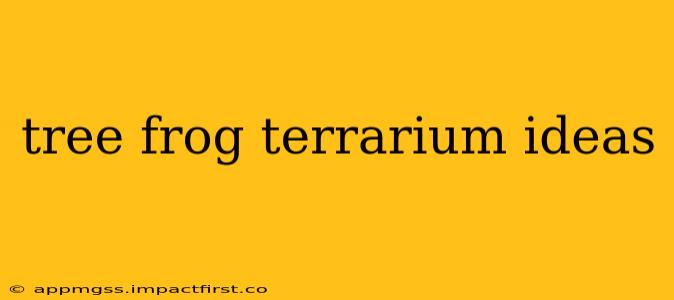Owning a tree frog is a rewarding experience, but providing the right environment is crucial for their health and happiness. A well-designed terrarium is key, mimicking their natural habitat to ensure they thrive. This guide delves into various tree frog terrarium ideas, covering everything from choosing the right enclosure to selecting appropriate plants and décor.
What Size Terrarium Do I Need for My Tree Frog?
The size of your terrarium depends entirely on the size of your frog and the number of frogs you plan to keep. A general rule of thumb is to provide ample space for your frog to climb, jump, and explore without feeling cramped. For a single small to medium-sized tree frog, a 10-gallon tank might suffice, while larger species or multiple frogs will require significantly larger enclosures, perhaps 20 gallons or more. Remember, bigger is always better when it comes to frog habitats! Vertical space is especially important to replicate their natural arboreal environment.
What Kind of Plants Are Good for a Tree Frog Terrarium?
Selecting the right plants is paramount. You need plants that are not only visually appealing but also provide cover, humidity, and climbing opportunities. Consider these options:
- Pothos: These hardy vines are easy to care for and readily available, providing excellent climbing surfaces.
- Bromeliads: These epiphytes offer attractive foliage and can hold water, increasing humidity.
- Orchids (certain species): Some orchid varieties thrive in humid environments and add a touch of elegance.
- Ficus: Certain ficus varieties are suitable, adding lush greenery to the terrarium.
- Moss: Various types of moss help maintain humidity and offer a natural aesthetic.
Important Note: Always research the specific needs of your tree frog species before selecting plants. Ensure that any plants you choose are non-toxic and safe for your amphibian companion.
How Do I Maintain the Right Humidity in a Tree Frog Terrarium?
Maintaining appropriate humidity is vital for your tree frog's health. Aim for a humidity level between 60% and 80%, depending on the specific species. Here are some ways to achieve and maintain this:
- Regular Misting: Misting the terrarium several times a day will help increase humidity.
- Substrate: Using a moisture-retentive substrate like coco coir or sphagnum moss helps keep humidity levels stable.
- Water Features: A small water dish or even a shallow waterfall will add humidity and provide a drinking source.
- Humidity Gauge: Invest in a reliable humidity gauge to monitor levels and adjust accordingly.
What Kind of Lighting Do Tree Frogs Need?
Tree frogs don't require intense lighting like some reptiles. However, they do need a light cycle to regulate their behavior and metabolism. A simple heat lamp or basking bulb is usually not necessary, and can even be detrimental. Instead, focus on providing a natural light cycle with 12 hours of light and 12 hours of darkness using a low-wattage UVB light bulb, which should be positioned outside the enclosure, providing natural-light-like ambience rather than direct heat. Always research the specific lighting needs of your frog species.
What Type of Substrate Is Best for a Tree Frog Terrarium?
The substrate you choose significantly impacts humidity levels and overall hygiene. Popular choices include:
- Coco Coir: A widely used substrate that retains moisture well and is easy to maintain.
- Sphagnum Moss: Provides excellent humidity and a natural look.
- Orchid Bark: Offers good drainage and aeration.
Avoid using substrates like sand or gravel, which can be ingested by your frog and cause digestive problems.
How Do I Decorate a Tree Frog Terrarium?
Decorating your terrarium should focus on creating a naturalistic and enriching environment. Include climbing branches, cork bark, and other elements that provide cover and enrichment. Avoid using sharp objects or anything that could potentially harm your frog.
Remember, always research the specific needs of your tree frog species before setting up your terrarium. By providing a well-designed and maintained habitat, you can ensure your tree frog thrives for many years to come.
